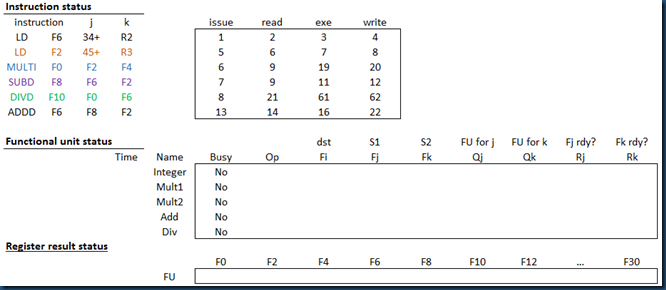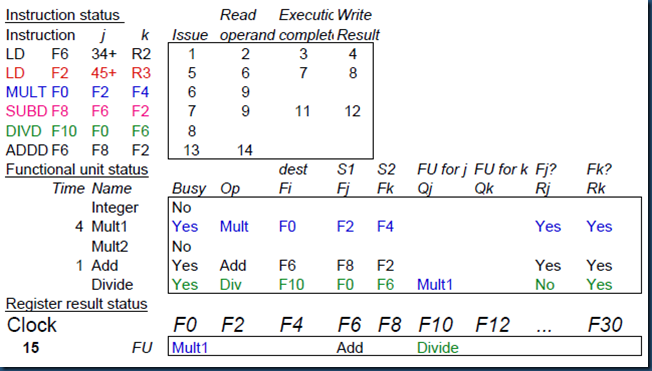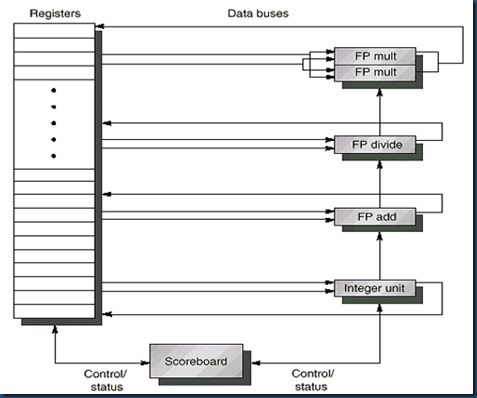scoreboarding
Reference docs:
https://en.wikipedia.org/wiki/Scoreboarding
SSC_course_5_Scoreboard_ex.pdf
1, what is scoreboarding
A method to dynamically schedule pipelining in case of out-of-order execution when there’re no conflicts and hardware is available.
The reason it’s called scoreboarding, as shown below, is because the way it determines whether an action is ready to go is just like a scoreboard in baseball game.
2, principle
In a scoreboard, the data dependencies of every instruction are logged. Instructions are released only when the scoreboard determines that there are no conflicts with previously issued and incomplete instructions.
The logging process is not added as part of the instruction; the log is recorded during instruction pipeline processing, so we should think scoreboarding as part of the pipeline.
3, scoreboarding stages and each stage’s resposibilities
After fetching, instructions would go through 4 stages: issue, read, execute and write back.
1) issue
what to do here: Check which registers will be read and written by this instruction. Instruction would stall until current instructions intending to write to the same register are completed.
issue = ID + structure/WAW hazard check
2) read
what to do here: After an instruction has been issued and correctly allocated to the required hardware module, the instruction waits until all operands become available.
Read stage is to avoid RAW hazard. For read stage to go forward, Rj,Rk should both be Yes (meaning see below).
3) execute
what to do here: When all operands have been fetched, the functional unit starts its execution.
4) write back
what to do here: In this stage the result is about to be written to its destination register.
In this stage, functional unit should be idle; src1/scr2 registers shoule be available and dst register should be idle.
This stage needs to avoid WAR.
4, data structure
Scoreboarding maintains 3 status tables: instruction status, functional unit status and register result status.
One demo see below:

1) instruction status
Record which above 4 stage an instruction is in.
2) register result status
Record which functional unit would write to which register.
3) functional unit status
Each functional unit maintains 9 fields to indicate its status:
- Busy: Indicates whether the unit is being used or not
- Op: Operation to perform in the unit (e.g. MUL, DIV or MOD)
- Fi: Destination register -- which register would be written
- Fj,Fk: Source-register numbers —src1 and src2 register number
- Qj,Qk: Functional units that will produce the source registers Fj, Fk – which operation will generate scr1 and scr2 results
- Rj,Rk: Flags that indicates when Fj, Fk are ready for and are not yet read. – whether src1 and src2 register is available
An example would look like this:

See reference pdf for details.
5, algorithm in function mode
Each stage of scoreboarding can be implemented as followed:
1) issue
function issue(op, dst, src1, src2)
wait until (!Busy[FU] AND !Result[dst]); // FU can be any functional unit that can execute operation op
-- 条件:(1) 当前FU没被使用; (2) 无其他活跃指令操作同一目的寄存器, 即无WAR风险
Busy[FU] ← Yes;
Op[FU] ← op;
F
i
[FU] ← dst;
F
j
[FU] ← src1;
F
k
[FU] ← src2;
Q
j
[FU] ← Result[src1];
Q
k
[FU] ← Result[src2];
R
j
[FU] ← Q
j
[FU] == 0;
R
k
[FU] ← Q
k
[FU] == 0;
Result[dst] ← FU;
2) read
function read_operands(FU)
wait until (R
j
[FU] AND R
k
[FU]);
-- 条件:Rj和Rk均为Yes
R
j
[FU] ← No;
R
k
[FU] ← No;
3) execute
function execute(FU)
// Execute whatever FU must do
4) write back
function write_back(FU)
wait until (∀f {(F
j
[f]≠F
i
[FU] OR R
j
[f]=No) AND (F
k
[f]≠F
i
[FU] OR R
k
[f]=No)})
-- 条件:FU可使用, scr1/scr2可使用, dst可使用
foreach f do
if Q
j
[f]=FU then R
j
[f] ← Yes;
if Q
k
[f]=FU then R
k
[f] ← Yes;
Result[F
i
[FU]] ← 0; // 0 means no FU generates the register's result
Busy[FU] ← No;
Again, above algorithm may look odd, they completely make sense we going through the pdf.
6, typical scoreboarding structure

2 FP multiply, 1 FP adder, 1 FP divider, 1 FP integer
7, scoreboarding limitation
(1) stall on name dependencies
For example,
MULT F4, F2, F2
ADDD F2, F0, F6
Actually above instructions are the same as:
MULT F4, F2, F2
ADDD F8, F0, F6
but scoreboadring cannot tell. To scoreboarding, this is a WAR hazard.
And it’s not difficult to conclude that scoreboarding may also see a name dependencies case as a WAW hazard.
(This limitation can be covered in Tomasulo’s Reservation Station/Renaming mechanism.)
(2) no forwarding hardware
(3) instruction parallelism is limited by the number of function units.
scoreboarding的更多相关文章
- Data Dependency
https://en.wikipedia.org/wiki/Data_dependency (There’s some misleading expression on the flow/data d ...
- Java:并发笔记-05
Java:并发笔记-05 说明:这是看了 bilibili 上 黑马程序员 的课程 java并发编程 后做的笔记 4. 共享模型之内存 本章内容 上一章讲解的 Monitor 主要关注的是访问共享变量 ...
随机推荐
- Codeforces 1174C Ehab and a Special Coloring Problem
题目链接:http://codeforces.com/problemset/problem/1174/C 题意:给你一个n,要你填充 下标由2 ~ n 的数组ai,要求下标互质的俩个数不能相等,并且数 ...
- 高手总结CSS书写技巧
这个时候我们就需要针对不同的浏览器去写不同的CSS,让它能够同时兼容不同的浏览器,能在不同的浏览器中也能得到我们想要的页面效果.这个针对不同的浏览器写不同的CSS code的过程,就叫CSS hack ...
- js面向对象编程:this究竟代表什么?第二篇
总觉得自己弄明确了js中this的含义.this总是指向调用方法的对象,作为方法调用,那么this就是指实例化的对象.但前几天自己写脚本却遇到了一个非常奇怪的问题. 代码例如以下: ...
- 更改idea启动内存信息
1.到idea的安装目录的bin下,找idea64.exe.vmoptions 文件 2.更改参数 对应的参数解释: -Xms1024m 设置IDEA初时的内存大小,提高Java程序的启动速度. ...
- Apache2.2+tomcat7 负载均衡配置
思路及步骤:第一步配置tomcat,第二步配置apache 服务器,第三步添加项目到tomcat中并测试 第一步配置tomcat 1,打开 第一个tomcat,conf文件夹下的server.xml ...
- PHP算法之IP 地址无效化
给你一个有效的 IPv4 地址 address,返回这个 IP 地址的无效化版本. 所谓无效化 IP 地址,其实就是用 "[.]" 代替了每个 ".". 示例 ...
- 如何优雅的在 vue 中添加权限控制
前言 在一个项目中,一些功能会涉及到重要的数据管理,为了确保数据的安全,我们会在项目中加入权限来限制每个用户的操作.作为前端,我们要做的是配合后端给到的权限数据,做页面上的各种各样的限制. 需求 因为 ...
- CF886F Symmetric Projections
题意:给你平面上n个点,问有多少条过原点的直线,使得这些点在该直线上的投影(做垂直,对应点)形成对称图形?n<=2000. 标程: #include<bits/stdc++.h> # ...
- CF774L Bars
题意:给你一个二进制表示是否可以吃巧克力.一共有k个巧克力,第一天和最后一天必须吃.最小化每两次吃巧克力的最大间隔? 标程: #include<bits/stdc++.h> using n ...
- jQuery实现的文字逐行向上间歇滚动效果示例
<!doctype html> <html> <head> <meta charset="utf-8"> <title> ...
